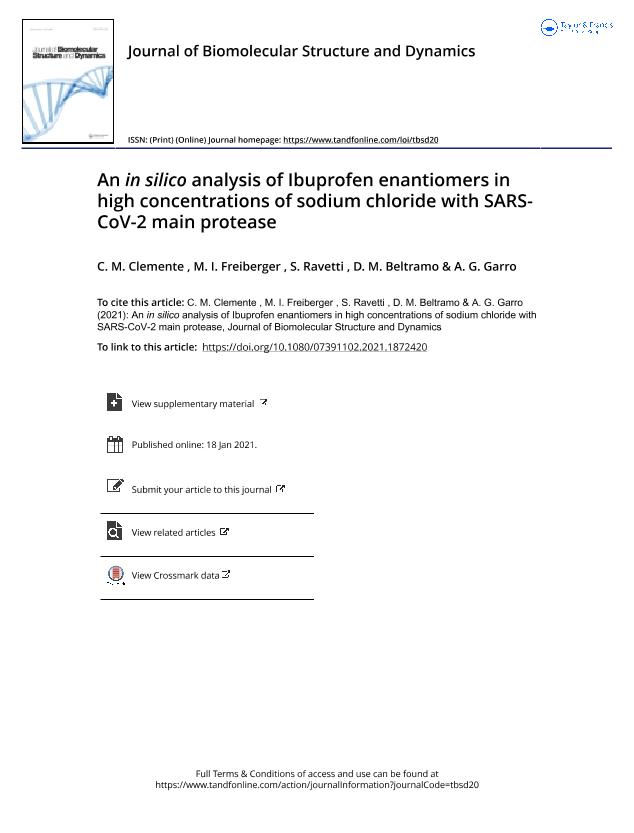Mostrar el registro sencillo del ítem
dc.contributor.author
Clemente, Camila Mara

dc.contributor.author
Freiberger, Maria Ines

dc.contributor.author
Ravetti, Soledad

dc.contributor.author
Beltramo, Dante Miguel

dc.contributor.author
Garro, Ariel Gustavo

dc.date.available
2021-12-03T14:28:20Z
dc.date.issued
2021-01
dc.identifier.citation
Clemente, Camila Mara; Freiberger, Maria Ines; Ravetti, Soledad; Beltramo, Dante Miguel; Garro, Ariel Gustavo; An in silico analysis of Ibuprofen enantiomers in high concentrations of sodium chloride with SARS-CoV-2 main protease; Taylor & Francis; Journal Of Biomolecular Structure & Dynamics; 2021; 1-2021; 1-12
dc.identifier.issn
0739-1102
dc.identifier.uri
http://hdl.handle.net/11336/148117
dc.description.abstract
2020 will be remembered worldwide for the outbreak of Coronavirus disease (COVID-19), which quickly spread until it was declared as a global pandemic. The main protease (Mpro) of SARS-CoV-2, a key enzyme in coronavirus, represents an attractive pharmacological target for inhibition of SARS-CoV-2 replication. Here, we evaluated whether the anti-inflammatory drug Ibuprofen, may act as a potential SARS-CoV-2 Mpro inhibitor, using an in silico study. From molecular dynamics (MD) simulations, we also evaluated the influence of ionic strength on the affinity and stability of the Ibuprofen–Mpro complexes. The docking analysis shows that R(−)Ibuprofen and S(+)Ibuprofen isomers can interact with multiple key residues of the main protease, through hydrophobic interactions and hydrogen bonds, with favourable binding energies (−6.2 and −5.7 kcal/mol, respectively). MM-GBSA and MM-PBSA calculations confirm the affinity of these complexes, in terms of binding energies. It also demonstrates that the ionic strength modifies significantly their binding affinities. Different structural parameters calculated from the MD simulations (120 ns) reveal that these complexes are conformational stable in the different conditions analysed. In this context, the results suggest that the condition 2 (0.25 NaCl) bind more tightly the Ibuprofen to Mpro than the others conditions. From the frustration analysis, we could characterize two important regions (Cys44-Pro52 and Linker loop) of this protein involved in the interaction with Ibuprofen. In conclusion, our findings allow us to propose that racemic mixtures of the Ibuprofen enantiomers might be a potential treatment option against SARS-CoV-2 Mpro. However, further research is necessary to determinate their possible medicinal use. Communicated by Ramaswamy H. Sarma.
dc.format
application/pdf
dc.language.iso
eng
dc.publisher
Taylor & Francis

dc.rights
info:eu-repo/semantics/openAccess
dc.rights.uri
https://creativecommons.org/licenses/by-nc-nd/2.5/ar/
dc.subject
COVID-19
dc.subject
DOCKING MOLECULAR
dc.subject
IBUPROFEN
dc.subject
MOLECULAR DYNAMICS
dc.subject
MPRO
dc.subject.classification
Otras Ciencias de la Computación e Información

dc.subject.classification
Ciencias de la Computación e Información

dc.subject.classification
CIENCIAS NATURALES Y EXACTAS

dc.title
An in silico analysis of Ibuprofen enantiomers in high concentrations of sodium chloride with SARS-CoV-2 main protease
dc.type
info:eu-repo/semantics/article
dc.type
info:ar-repo/semantics/artículo
dc.type
info:eu-repo/semantics/publishedVersion
dc.date.updated
2021-11-09T18:55:12Z
dc.identifier.eissn
1538-0254
dc.journal.volume
2021
dc.journal.pagination
1-12
dc.journal.pais
Reino Unido

dc.journal.ciudad
Londres
dc.description.fil
Fil: Clemente, Camila Mara. Consejo Nacional de Investigaciones Científicas y Técnicas. Centro Científico Tecnológico Conicet - Córdoba; Argentina. Universidad Nacional de Villa María. Instituto Académico Pedagógico de Ciencias Básicas y Aplicadas; Argentina
dc.description.fil
Fil: Freiberger, Maria Ines. Consejo Nacional de Investigaciones Científicas y Técnicas. Oficina de Coordinación Administrativa Ciudad Universitaria. Instituto de Química Biológica de la Facultad de Ciencias Exactas y Naturales. Universidad de Buenos Aires. Facultad de Ciencias Exactas y Naturales. Instituto de Química Biológica de la Facultad de Ciencias Exactas y Naturales; Argentina
dc.description.fil
Fil: Ravetti, Soledad. Consejo Nacional de Investigaciones Científicas y Técnicas. Centro Científico Tecnológico Conicet - Córdoba. Centro de Investigaciones y Transferencia de Villa María. Universidad Nacional de Villa María. Centro de Investigaciones y Transferencia de Villa María; Argentina. Universidad Nacional de Villa María. Instituto Académico de Ciencias Humanas; Argentina
dc.description.fil
Fil: Beltramo, Dante Miguel. Universidad Católica de Córdoba; Argentina. Provincia de Córdoba. Ministerio de Ciencia y Técnica. Centro de Excelencia en Productos y Procesos de Córdoba; Argentina. Consejo Nacional de Investigaciones Científicas y Técnicas. Centro Científico Tecnológico Conicet - Córdoba; Argentina
dc.description.fil
Fil: Garro, Ariel Gustavo. Provincia de Córdoba. Ministerio de Ciencia y Técnica. Centro de Excelencia en Productos y Procesos de Córdoba; Argentina. Universidad Nacional de Villa María. Instituto Académico de Ciencias Humanas; Argentina. Consejo Nacional de Investigaciones Científicas y Técnicas. Centro Científico Tecnológico Conicet - Córdoba. Centro de Investigaciones y Transferencia de Villa María. Universidad Nacional de Villa María. Centro de Investigaciones y Transferencia de Villa María; Argentina
dc.journal.title
Journal Of Biomolecular Structure & Dynamics

dc.relation.alternativeid
info:eu-repo/semantics/altIdentifier/url/https://www.tandfonline.com/doi/full/10.1080/07391102.2021.1872420
dc.relation.alternativeid
info:eu-repo/semantics/altIdentifier/doi/https://doi.org/10.1080/07391102.2021.1872420
Archivos asociados
